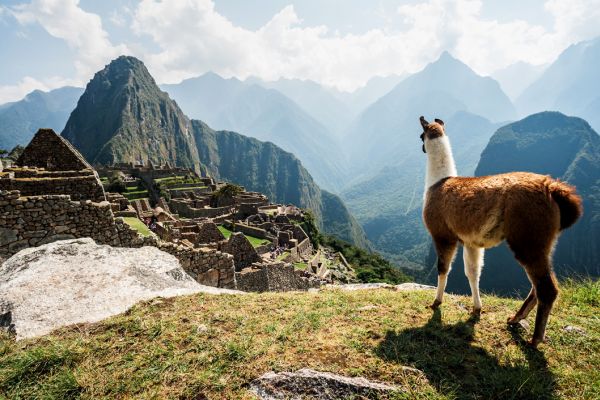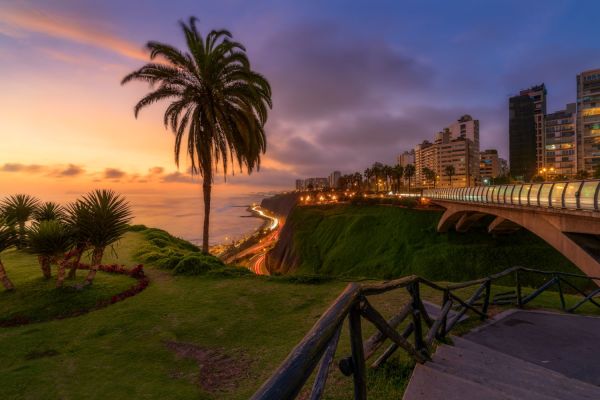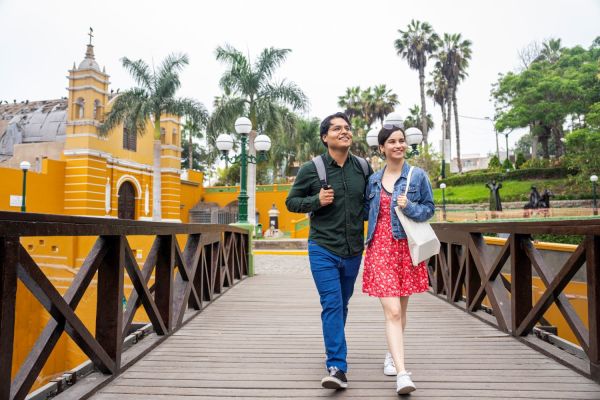LimaTravel Guide
Lima is Peru’s capital city and the largest metropolis on South America’s arid Pacific coast. This ancient city was once home to the Lima, Inca and other Indigenous cultures before being founded by the Spanish in 1535. As you’d expect, Lima is a historical and cultural gem.
At its heart, you'll find the well-preserved Historic Centre, a UNESCO World Heritage Site showcasing beautiful colonial architecture and merging the city's European and Indigenous influences. Lima also boasts a pyramid and pre-Columbian ruins on its outskirts!
Costa Verde, the city’s scenic coastal area of beaches, promenades and parks, runs between the ocean and the cliffs. If you’re seeking action, there’s paragliding with sea views, surfing and golf.
Lima is also regarded as South America’s culinary capital and attracts foodies from all over the world.
Visiting Lima allows you to dive deep into South America’s ancient past while enjoying a modern urban experience. Find out everything this energetic city offers!
Explore Lima
Where to stay in Lima?
Lima has many hotels and budget-friendly accommodations to choose from. Whether you prefer historic charm, quiet residential areas or the excitement of all the action, there’s a perfect spot for you.
Staying in the historical heart of Lima puts many attractions right on your doorstep. For example, the luxury Sheraton Lima Historic Centre is just a few steps from the Plaza San Martín and Lima Cathedral. This iconic hotel offers spacious rooms (many with private balconies) and views of the city’s landmarks. It also has a fitness centre, a seasonal outdoor pool and two on-site dining options specialising in classic Peruvian cuisine.
If you’re on a tight budget, Hostal Plaza Mayor Lima is as centrally located as it gets on the Plaza Mayor (Plaza de Armas). While not a hostel in the typical sense (no dormitories), this budget accommodation offers seven room types — some with minibars — and specialises in romantic and birthday packages!
For a bohemian vibe, book your stay in the Barranco district, renowned for its artistic spirit, colourful murals and galleries. Hotel B, a gorgeous restored Belle Époque (late 19th century to early 20th century) mansion, near the Bridge of Sighs (Barranco’s famous romantic landmark), will appeal to art enthusiasts. The boutique hotel exhibits local artworks on its walls, available for purchase. It also offers curated experiences like cooking and cocktail-making classes and art tours.
This is Lima’s most popular tourist district, known for its ocean views, pulsating nightlife, and high-end shopping and dining. JW Marriott Hotel Lima is your go-to for a 5-star luxury experience close to the beach. It offers rooms with panoramic views, a spa, a gym and several dining options, including a sushi bar.
For upmarket accommodation that’s more intimate, Casa Andina Premium Miraflores is a boutique hotel in Lima that’s favoured for traditional Peruvian hospitality. It has a spa, a heated swimming pool and 5-star credentials — plus it's within walking distance of attractions like Parque Kennedy (Kennedy Park) and the Larcomar Shopping Centre.
Looking for value for money? The intriguingly named KACLLA, The Healing Dog Hostel has cheerful private rooms and dormitories, a yoga room, a focus on Peruvian tradition, and everything healthy and organic. The word “Kaclla” has more than one meaning but the one we like best is “Peruvian hairless dog” — and yes, he’s on-site, ready to welcome you!
The Country Club Lima Hotel, just outside Barranco in the neighbouring San Isidro district, offers a touch of grandeur in a 1927 national monument. Combining old-world charm with modern amenities, it’s also home to 300 unique pieces of viceregal art (artwork created during Spanish colonial rule — 16th to early 19th centuries). An exclusive agreement with the Lima Golf Club means you can enjoy a few rounds of golf while your partner gets pampered at the spa. Later, indulge in fine dining at the Perroquet Restaurant.
Believe us when we say, this is just the start. Book your accommodation today!
Things to do in Lima
Lima offers many activities and attractions for all kinds of travellers that showcase its rich history, fascinating culture and outdoor adventures. Plus, Lima is a popular beach destination in summer. To see the main attractions while getting valuable insights, we recommend joining a walking tour offered by Lima locals.
Start your exploration at the Historic Centre (Centro Histórico) with its plazas, baroque places of worship, like the Lima Cathedral, and colonial buildings. Visit the Plaza Mayor (Plaza de Armas) — the original site where Lima was founded — and you’ll come across landmarks like the Government Palace. The Monastery of San Francisco, a fascinating church complex with catacombs dating back more than 450 years and an exceptional library with over 25,000 volumes, is just around the corner.
Ever seen a pyramid in a city? When you stay in Lima, Peru, you will! Head to the Miraflores district, where the Huaca Pucllana rises from the midst of modern urban buildings. Built around 400 AD from adobe and clay, this pyramid is surprisingly well-preserved. It's part of an archaeological site with plazas and other structures where ceremonies were performed. Pay your entrance fee for a tour of this heritage site, pop into the museum, then enjoy a traditional Peruvian dinner afterwards at the on-site restaurant and see the pyramid lit up!
If you’re keen to delve into art and history, the Larco Museum in the Pueblo Libre district, is renowned for its collection of pre-Columbian art, including pottery, intricate jewellery and erotic artefacts from Peru’s ancient civilisations. Housed in an 18th-century mansion, the museum takes you on a journey into the distant past.
Looking for a thrill? Paragliding over Costa Verde is an exhilarating experience with unforgettable ocean views. The paragliding launch site, Parapuerto Miraflores, is in Antonio Raimondi Park, where experienced pilots offer tandem paragliding sessions.
Lima boasts several golf clubs and courses, so if you’re a golf enthusiast, you’re in the right city! The prestigious Lima Golf Club in the San Isidro district caters to both novices and pros and offers an 18-hole championship course, a driving range and practice bunker, among other amenities and sports. The Los Inkas Golf Club in Santiago de Surco is known for hosting major tournaments, so you know it’s top-notch. The 18-hole championship golf course is a par 72.
While not in Lima, our Travel Guide would be incomplete if we didn’t mention Machu Picchu, the country’s most iconic and globally recognised ancient site. Often referred to as the Lost City of the Incas, this UNESCO World Heritage Site is set high in the Andes Mountains.
While Machu Picchu isn’t a day trip from Lima, many tourists who visit the capital make their way to this awe-inspiring attraction. To get there, you’ll need to take a 1.5-hour flight from Lima to Cusco, followed by a train ride of about two hours to the town of Aguas Calientes and then a short (+/- 30 minutes) bus trip up to the ancient citadel. Guided tours are on offer from Lima to give you a real immersion in this once-in-a-lifetime experience.
The Pachacamac Ruins in the Lurin River Valley, on the outskirts of Lima, offer a fascinating glimpse into the ancient Lima, Inca, Wari and Ichma (also Ychma) civilisations. The complex built of adobe and stone dates back to around 200 AD, and you can explore what remains of pyramids, temples (the largest is the Temple of the Sun), palaces and open-air plazas. There’s also an on-site museum that traces the history of Pachacamac and exhibits artefacts from archaeological digs.
Agua Dulce in the Chorrillos district is considered the most popular beach in Lima. Sandy and with calm waters, it’s ideal for swimming and a favourite among families. Agua Dulce is easily accessible by public transport. Waikiki in Miraflores — not Hawaii — is a lovely, long stretch of beach with good amenities. Frequented by surfers and other water-sport enthusiasts, you can walk there from the Metropolitano station, Ricardo Palma. Another option in Miraflores is Makaha Beach. It offers a laid-back experience with minimal amenities but several surf schools where you can take a class or rent gear.
This urban park in the Miraflores district was named after US President John F. Kennedy, and its beautiful gardens draw locals and tourists alike to enjoy the outdoors. Arts and cultural events are often hosted here, and cat lovers take note! Parque Kennedy is also known as the “cat park” as it’s home to many friendly stray cats who have become part of the attraction. These lucky felines have caring local volunteers looking after them.
Looking for an immersive experience? Then a tour is the way to go.
Flights to Lima
Lima food and drink
Lima’s culinary scene is diverse, reflecting its many cultural influences including Spanish, Andean, Italian, African and Asian. This foodie mecca boasts some of the world’s top restaurants serving traditional, international and fusion dishes. Try Peru's national dish, ceviche (marinated fish) and look out for "chifa" restaurants (Chinese-Peruvian fusion cuisine) with dishes like arroz chaufa (fried rice) and tallarín saltado (stir-fried noodles) on the menu.
The culinary landscape in the Historic Centre includes traditional Peruvian dishes cooked up in iconic restaurants that have stood the test of time. El Cordano, for example, has been serving politicians and intellectuals since 1905. The cosy interior features a huge wooden bar and wooden furniture, while on the menu are Peruvian staples like lomo saltado (stir-fried beef), tacu tacu (pan-fried rice and beans) and other hearty, simple dishes. You can enjoy al-fresco dining here, too.
Barranco is home to Lima’s best bars and pubs, offering craft beer and unique cocktails like Peru’s national drink: the Pisco Sour (pisco grape spirit, lime, egg white, Angostura Bitters and syrup). For an artistic foodie twist, visit Isolina Taberna Peruana, a traditional tavern that dishes up criollo cuisine — a fusion of Indigenous, Spanish and African influences — like ají de gallina (creamy chicken stew).
Central has been named the best restaurant in Latin America multiple times, and in 2023, came first in the World's 50 Best Restaurants. There are no traditional dishes here, but rather an experimental and unusual approach where you choose up to 14 plates that showcase ingredients from the various altitudes in Peru, from below sea level to the mountain peaks. It’s a delicious sensory adventure!
Another Miraflores culinary masterpiece is Maido, which merges Japanese cooking techniques with Peruvian ingredients to create Nikkei cuisine. The restaurant is famous for sushi and its tasting menus.
For casual dining, we recommend La Mar, one of the best seafood restaurants in the city. Here, ceviche is the star of a menu that includes octopus, clams and decadent desserts.
Lima has an exciting street food culture that comes alive at night when vendors emerge and set up their stalls and charcoal grills throughout the city. You can also tuck into street food at markets like the Surquillo Market near Parque Kennedy in Miraflores.
Here are some must-try dishes:
- Anticuchos: Skewered and grilled beef heart marinated in vinegar, chilli and herbs and served with boiled potato
- Choclo con queso: Grilled corn topped with cheese and spicy sauce
- Tamales: Corn or potato dough mixed with meat and spices, wrapped in banana leaves and boiled
- Picarones: A Peruvian doughnut of sweet potato and squash, drizzled with cane syrup
Get a real taste for the local cuisine by booking a tour.
Where to shop in Lima?
Lima caters to all kinds of shoppers and budgets, from modern shopping centres and boutique stores to traditional markets selling local produce and handicrafts.
Jockey Plaza in the Santiago de Surco district offers an upscale shopping experience and is one of the largest malls in Lima. It houses luxury brands like Prada and Gucci, and international chain stores such as Forever 21 and Zara. Restaurants, a cinema and a fitness centre make it a one-stop destination.
If you’re looking for souvenirs and Peruvian crafts to take home, head to the lively Mercado Indio (Indian Market) in Miraflores, a collection of small shopping arcades where you’ll find a colourful selection of textiles, woven rugs, handcrafted jewellery, Panama hats and musical instruments for sale.
The nearby Inca Market is a tourist favourite for affordable trinkets, jewellery, ceramics, shawls and much more, but shop around as you may find the same items priced differently.
Gamarra in La Victoria, not far from Miraflores, is a large street-side market with many small shops and vendors that focus exclusively on fashion, including local brands and super-affordable knockoffs. Wear comfy shoes and be prepared for crowds!
Mercado Central (Central Market) in Barrios Altos, is one for the foodies. This busy, undercover market spans several storeys and sells a huge selection of local delicacies, meats, unusual ingredients and fresh produce.
Pair your shopping with ocean views at Larcomar, a cliffside complex on the Miraflores boardwalk. It offers high-end boutiques, Peruvian fashion and entertainment. You'll also find various international stores and restaurants capitalising on the scenery.
If you're a bit of a "treasure hunter", Avenida La Paz in Miraflores is a pedestrian street known for its antique shops, rare finds and religious art.
Looking for a safe and simple way to bring your money when you travel? Our Travel Money Card has you covered!
When is the best time to travel to Lima?
Lima is in a desert region spanning the valleys of three rivers: the Chillón, Rímac and Lurín. It’s also on the coastline of the Pacific Ocean. Therefore, it has a mild desert climate with high humidity and little rainfall, making it a year-round destination.
Summer is from December to April and it’s also peak tourist season. At this time of year, the temperatures range from 25°C to 30°C (77°F to 86°F) and February is the hottest month. Visit Lima in summer if enjoying the beaches is part of your itinerary.
The winter months (June to October) are cloudy and cooler, with daytime temperatures from 16°C to 18°C (61°F to 64°F). June to September is permanently cloudy and August is the coldest month with frequent drizzle.
Lima experiences a phenomenon called garúa in winter, a dense coastal mist that blankets the hills and coastline, cooling the city significantly. Winter is also the off-peak season with fewer tourists and lower accommodation rates. May and November are Lima’s transitional months.
Don't miss out. Book your flight today!
How to get around Lima
Navigating Lima’s sprawling urban landscape and chaotic traffic can be daunting at first, but the city offers various transportation options to help ease your journey.
The metro is the fastest way to travel and there are two lines: Line 1 runs above ground from Villa el Salvador to San Juan de Lurigancho, while Line 2 stretches 5km underground and crosses five stations between Evitamiento and Mercado Santa Anita. Line 2 is driverless and fully automated. Buy a rechargeable electronic card at any metro station to pay for your fare.
Buses in Lima include the Metropolitano Bus Rapid Transit, Corredor Azul and an older bus system. The Metropolitano runs along a dedicated lane from Chorrillos in the south to Independencia in the north. It’s particularly useful for travelling between Miraflores, San Isidro and the Historic Centre. The modern stations have passenger information booths, and you can easily find timetables and route information. You can pay for your fare with your rechargeable electronic card.
Corredor Azul is a public bus transportation provider in Lima covering six routes with almost 160 stops. You’ll have to queue for these buses and pay cash on board. For public transport routes and schedules, we suggest using an app like Moovit.
Lima’s older bus system, consisting of privately owned micro-buses (colectivos) and larger colourful buses, is extensive but quite complex. While a cheaper option, the vehicles can be crowded and challenging to navigate for non-Spanish speakers as you need to flag them down on main roads and there are no set timetables or routes. You’ll also need to have local currency on hand for your fare.
In Lima you’ll see many yellow taxis, but they’re more expensive than public transport and most taxis don’t use meters. Always negotiate the fare before getting in. You can also use Uber or Cabify.
Renting an e-bike is popular option in areas like Miraflores and Barranco. While road conditions in Lima aren’t ideal for cycling in all areas, the city’s coastal parts have dedicated bike paths, known as ciclovías. One famous route is along the Costa Verde in Miraflores, offering gorgeous views of the Pacific.
Let us help you organise your own wheels for exploring. Hire a car today.










